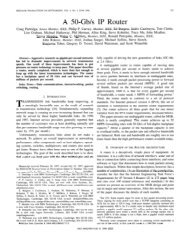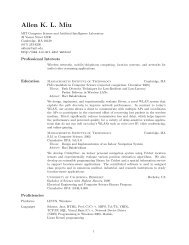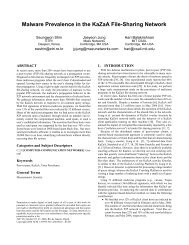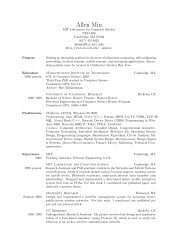Chord - Networks and Mobile Systems - MIT
Chord - Networks and Mobile Systems - MIT
Chord - Networks and Mobile Systems - MIT
Create successful ePaper yourself
Turn your PDF publications into a flip-book with our unique Google optimized e-Paper software.
finger table keys<br />
start int. succ. 6<br />
7 [7,0) 0<br />
0 [0,2) 0<br />
2 [2,6) 3<br />
6<br />
5<br />
4<br />
finger table keys<br />
start int. succ.<br />
1 [1,2) 1<br />
2 [2,4) 3<br />
4 [4,0) 6<br />
7<br />
0<br />
1<br />
finger table keys<br />
start int. succ. 1<br />
2 [2,3) 3<br />
3 [3,5) 3<br />
5 [5,1) 6<br />
(a)<br />
3<br />
2<br />
finger table keys<br />
start int. succ. 2<br />
4 [4,5) 6<br />
5 [5,7) 6<br />
7 [7,3) 0<br />
finger table keys<br />
start int. succ. 6<br />
7 [7,0) 0<br />
0 [0,2) 0<br />
2 [2,6) 3<br />
6<br />
7<br />
5<br />
0<br />
4<br />
finger table keys<br />
start int. succ.<br />
1 [1,2) 0<br />
2 [2,4) 3<br />
4 [4,0) 6<br />
(b)<br />
1<br />
3<br />
2<br />
finger table keys<br />
start int. succ. 1<br />
4 [4,5) 6<br />
5 [5,7) 6<br />
7 [7,3) 0<br />
2<br />
Figure 5: (a) Finger tables <strong>and</strong> key locations after node 6 joins. (b) Finger tables <strong>and</strong> key locations after node 3 leaves. Changed entries are shown<br />
in black, <strong>and</strong> unchanged in gray.<br />
init finger table pseudocode in Figure 6. Naively performing<br />
find successor for each of the finger entries would give a runtime<br />
of £¥¤ ¦©¨<br />
. To reduce this, checks whether the §<br />
¢<br />
finger is also the correct ¤ <br />
§ finger, for each . This hap-<br />
<br />
finger § pens when interval does not contain any node, <strong>and</strong> <br />
thus<br />
node finger start. It can be shown that the change<br />
finger §<br />
reduces the expected (<strong>and</strong> high probability) number of finger entries<br />
that must be looked up to £¥¤§¦©¨<br />
, which reduces the ¢ £¥¤§¦¨ overall<br />
<br />
¢ time to .<br />
As a practical optimization, a newly joined node can ask an<br />
immediate neighbor for a copy of its complete finger table <strong>and</strong> its<br />
predecessor. can use the contents of these tables as hints to help<br />
<br />
it find the correct values for its own tables, since ’s tables will be<br />
similar to its neighbors’. This can be shown to reduce the time to<br />
fill the finger table to £¥¤§¦©¨<br />
. ¢<br />
Updating fingers of existing nodes: Node will need to be entered<br />
into the finger tables of some existing nodes. For example, in<br />
Figure 5(a), node 6 becomes the third finger of nodes 0 <strong>and</strong> 1, <strong>and</strong><br />
the first <strong>and</strong> the second finger of node 3.<br />
Figure 6 shows the pseudocode of the update finger table function<br />
that updates existing finger tables. Node will become § the<br />
finger of node if <strong>and</strong> only if (1) precedes by at least , <strong>and</strong><br />
(2) § the finger of node succeeds . The first node, , that can<br />
meet these two conditions is the immediate predecessor of .<br />
Thus, for a given , the algorithm starts with § the finger of node<br />
, <strong>and</strong> then continues to walk in the counter-clock-wise direction<br />
<br />
on the identifier circle until it encounters a node § whose finger<br />
precedes .<br />
We show in the technical report [21] that the number of nodes<br />
that need to be updated when a node joins the network is £¥¤§¦©¨<br />
¢<br />
with high probability. Finding <strong>and</strong> updating these nodes £¥¤§¦©¨ <br />
takes<br />
time. A more sophisticated scheme can reduce this time<br />
¢<br />
to £¥¤§¦©¨<br />
; however, we do not present it as we expect implemen-<br />
¢<br />
tations to use the algorithm of the following section.<br />
Transferring keys: The last operation that has to be performed<br />
when a node joins the network is to move responsibility for all<br />
the keys for which node is now the successor. Exactly what this<br />
entails depends on the higher-layer software using <strong>Chord</strong>, but typically<br />
it would involve moving the data associated with each key to<br />
the new node. Node can become the successor only for keys that<br />
were previously the responsibility of the node immediately following<br />
, so only needs to contact that one node to transfer responsibility<br />
for all relevant keys.<br />
#define successor finger § node<br />
// node joins the network;<br />
// is an arbitrary node in the network<br />
<br />
( if )<br />
init table( finger );<br />
update others();<br />
// move keys in from successor<br />
else // is the only node in the network<br />
for to<br />
§ node ;<br />
finger<br />
predecessor ;<br />
// initialize finger table of local node;<br />
// is an arbitrary node already in the network<br />
© <br />
<br />
§ node find successor§ § ;<br />
finger<br />
successor predecessor predecessor;<br />
predecessor ;<br />
successor<br />
for to<br />
finger § if start finger § node <br />
§ node finger § node<br />
finger<br />
else<br />
§ node <br />
finger<br />
find successor finger § start ;<br />
<br />
// update all nodes whose finger<br />
// tables should refer to <br />
<br />
<br />
for to<br />
// find last node § whose finger might be<br />
find predecessor ;<br />
update finger table ;<br />
// if is § finger of , update ’s finger table with <br />
<br />
<br />
§ finger § node<br />
if<br />
§ node ;<br />
finger<br />
predecessor; // get first node preceding <br />
<br />
update finger table ;<br />
<br />
Figure 6: Pseudocode for the node join operation.











